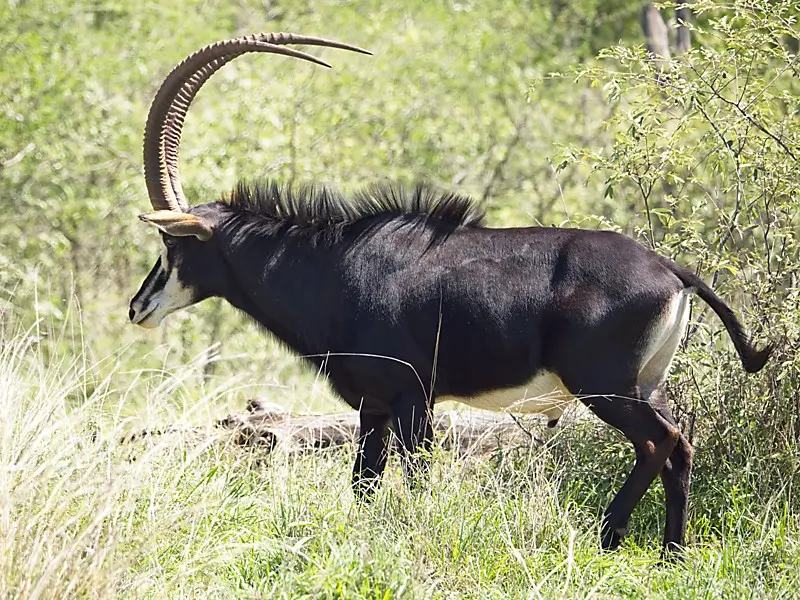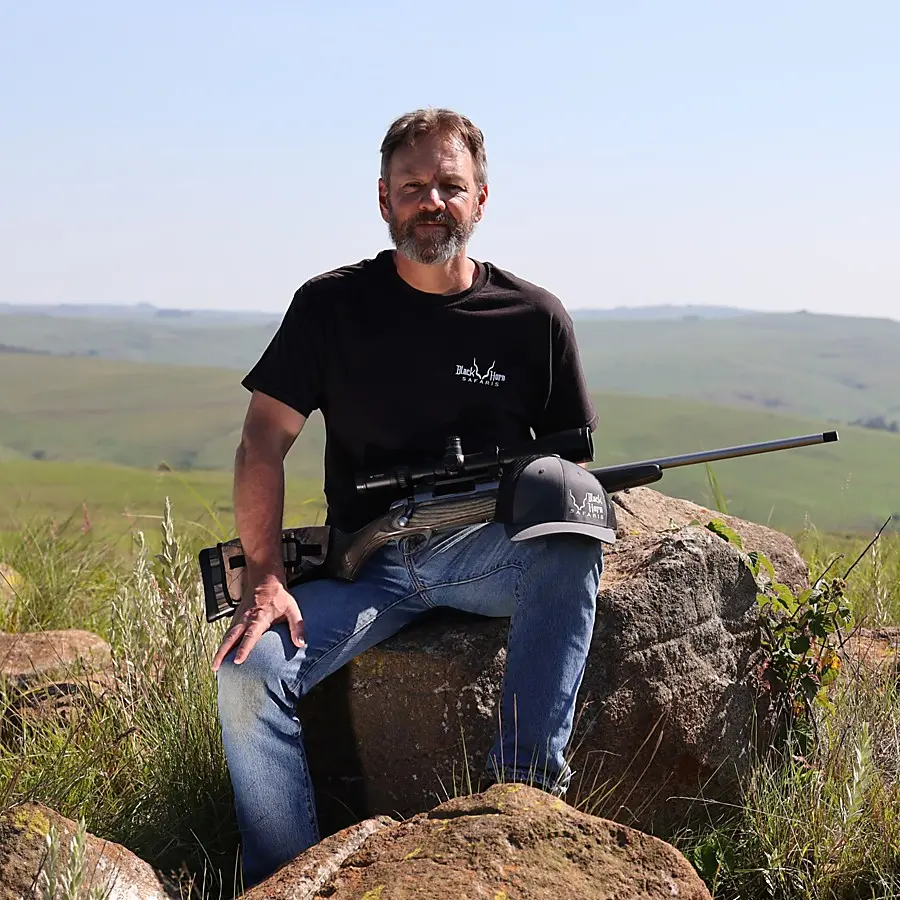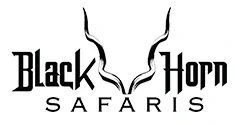Hunting has long been an essential part of human history, providing sustenance, materials, and even cultural experiences. In Africa, hunting is not only a favorite pastime but also a significant contributor to the country’s tourism industry. One of the most sought-after and majestic animals to hunt in the region is the Sable Antelope. We discuss a hunt in South Africa for Sable, covering their description, subspecies, habitat, trophy size, recommended hunting methods, bow hunting, and the cost of a safari.
Description and Size
The sable antelope (Hippotragus niger) is a large, powerful, and strikingly beautiful African antelope. Bulls are characterized by their impressive curved horns that can grow up to 65 inches (165 cm) long, while females have slightly thinner and shorter head gear. Mature males of this large antelope species have a glossy jet black coat, white facial markings and a white belly, they are a beautiful animal, while females and young males have a reddish- dark brown coat. Both sexes carry horns. Their robust build, with a shoulder height of approximately 54-60 inches (140-150 cm) and a body length of around 94-110 inches (240-280 cm). A Bull can weigh up to 550 lbs (250 kg), while females typically weigh around 450 lbs (200 kg). They are truly one of the most regal antelope in South Africa. African Wildlife Foundation.


Subspecies
There are four recognized subspecies, each with distinct coloration and range:
Southern Sableor common variety (Hippotragus niger niger): Found in South Africa, Zimbabwe, and southern Botswana.
Zambian Sable(Hippotragus niger kirkii): Located in Zambia and eastern Angola.
Eastern Sable(Hippotragus niger roosevelti): Inhabits Tanzania, Malawi, and northern Mozambique.
Giant Sable(Hippotragus niger variani): Endemic to the Cuanza Norte province of Angola and considered the rarest subspecies.
Hunt Sable – Habitat and Preferences
Sable prefer savannah woodlands and grasslands with ample tree cover and water sources. They thrive in areas with medium to tall grasses and avoid open plains or dense forests. They are herbivorous, feeding primarily on grasses and occasionally browsing leaves and shoots from trees.
Sable Hunting – Areas of Known Best Trophy Quality
The Limpopo Province of South Africa, North West and the northern parts of KwaZulu-Natal are well-known for their exceptional trophy quality. These regions offer ideal habitats, with ample food and water sources, and have been successful in promoting conservation through sustainable hunting practices. They are also found in Orange Free State and Eastern Cape.
Hunt Sable Antelope – Water Dependence
They are relatively water-dependent animals. They require regular access to water sources to stay hydrated, especially during the hot and dry seasons. Unlike some other African animals that can survive for extended periods without water, Sable need to drink at least every two to three days.
Their reliance on water makes them more predictable in their movements, as they often frequent waterholes, rivers, or other water sources within their home range. This water dependence makes them easier to locate while scouting. By focusing on areas with reliable water sources the tracks of bulls can be followed. Ambush hunting near these water sources can be particularly effective, as Sable visit them to quench their thirst and are more likely to be found moving between water and food sources.
In addition, the dependence on water shapes their habitat preferences. As mentioned earlier, they thrive in savannah woodlands and grasslands with ample tree cover and water sources. They avoid areas with scarce water availability, as it affects not only their hydration but also the availability of food resources such as grasses and leaves.
Trophy Sable Size
A mature Sable bull horns can measure between 38 to 53 inches in length, with trophy-size animals typically being longer than 40 inches. Trophy quality is determined by the horns’ length, thickness, and overall shape, with a deep high curve and sharp tips considered the most desirable.
Sable in South Africa – Hunting Rifle Recommendations
A suitable rifle should be chambered for a medium to large caliber cartridge, capable of delivering a quick and humane kill. Recommended calibers include .308 Winchester,.30-06 Springfield, and 7mm Remington Magnum. Heavier calibers like the .375 H&H Magnum or the .300 Winchester Magnum can also be used, especially if targeting larger game during the hunting trip. A high-quality, variable power scope with a minimum of 3-9x magnification is recommended for optimal shot placement. Premium quality ammunition should be used with a minimum weight 180 gr bullet.
Shot placement on Safari
Proper shot placement is crucial to ensuring a quick, humane, and ethical kill. As with any big game, the goal is to target essential organs, such as the heart and lungs, to cause rapid blood loss and minimize suffering. Here are some guidelines for shot placement on a hunt.
The Broadside Shot:
When the animal is standing perpendicular to the hunter, the side-on presentation calls for the high shoulder shot . Aim for the shoulder area, straight up the foreleg, about one third of the way up from the bottom of the chest. This shot targets the heart and lungs, which are vital for a quick and ethical kill. A well-placed shot will likely result in the animals dropping within close proximity or even on the spot.
Quartering-away Shot:
If the animal is slightly angled away from the hunter, a quartering-away shot can be very effective. Aim for a point slightly behind the shoulder and in line with the offside leg, where the bullet or arrow will penetrate through the ribcage and into the vital organs. Be cautious not to aim too far back, as this could result in a gut shot, causing unnecessary suffering and a difficult tracking job.
Frontal Shot:
Although not the most desirable shot angle when hunting, a frontal shot can be effective if taken at close range and is properly placed. Aim for the center of the chest, where the neck meets the body, targeting the heart, lungs, and major blood vessels. Keep in mind that this shot angle presents a smaller target area, increasing the risk wounding. It is essential to be confident in your shooting abilities and be prepared for a quick follow-up shot if necessary.
Neck Shot:
A neck shot can be an effective option for experienced shooters. If they are confident in their shooting abilities. The shot should be placed in the center, about halfway between the head and the shoulder. This shot placement targets the spinal vertebrae, which, if hit, will result in an instant and humane kill. However, the target area is relatively small, and a misplaced shot can lead to wounding or a lengthy tracking job.
When you hunt Sable avoid taking shots when it is facing directly away from you or is at an extreme angle. These shot angles do not provide a clear path to the vital organs and have a high risk of wounding. Always prioritize a clean, ethical shot over taking a risky, low-percentage shot. You do not want to pay a trophy fee and have nothing to show for it.
In summary, proper shot placement on a South African Sable is essential for a quick and humane kill. Broadside and quartering-away shots are the most desirable angles, targeting the heart and lungs. Frontal and neck shots can be effective but should only be attempted by experienced shots who are confident in their shooting abilities. Always prioritize ethical practices and be prepared to exercise patience and restraint when the perfect shot is not available.
Danger of Sable Antelope Hunting
While Sable are not typically considered aggressive or dangerous when not wounded they will charge and use their horns if cornered. Caution, preparation, and respect for the animal should always be observed when hunting any game species and especially sable.
Wounded Animal
A wounded Sable can become dangerous and unpredictable. If threatened, cornered, or in pain, the animal may charge at the hunter in self-defense, using its sharp horns as weapons. Always ensure your is shot placed to minimize the risk of wounding the animal, and be prepared for a follow-up shot if needed.


Most Successful Hunting Methods for Africa
Spot and Stalk:
This method involves carefully scouting the hunting area, locating common Sable herds, and then stalking within shooting range. The hunter must be patient and stealthy, taking advantage of the terrain and natural cover to remain undetected.
Ambush Hunting:
This technique requires a thorough understanding of Sable behavior and movement patterns. The guide may decide to set up ambush positions near waterholes, feeding areas, or well-used trails, waiting for a good Sable to come within range.
Bow Hunting Hipotragus Niger in South Africa
Bow hunting Sable Antelope in Africa is challenging but rewarding. A high-quality compound bow or crossbow with a draw weight of at least 70 lbs is recommended, ensuring sufficient kinetic energy for ethical kills. Arrows should be equipped with razor-sharp, fixed or mechanical broad heads for maximum penetration and damage.
Archers should practice regularly to ensure accurate shooting, focusing on vital areas such as the heart and lungs. Since they have a keen sense of smell, hearing, and sight, bow hunters must be particularly cautious and stealthy in their approach. Camouflage clothing, scent control, and minimizing noise are crucial to success. As with rifle hunting, when you bow hunt you can employ the spot and stalk or ambush, methods to increase their chances of success.
The Cost of Sable Hunts
The price for Sable hunting or the trophy fee is: $ 5 000.
This is the fee for the animal. To this you still need to add the day fees.
These opportunities are available for Rifle and Bow hunting.
The cost of a Sable hunting Package can vary widely depending on factors such as the duration of the hunt, the hunting area, the quality of the hunt lodge, and size of the trophies. On average, a 7-10 day sable trophy hunt, including trophy fee, can cost from $7,500.00 to $10,000.00 USD. Hunts vary among hunting outfitters and packages so find one that best suits your preferences.
Additional costs to consider include airfare, taxidermy, dip and pack and shipping of trophies, and tips for guides and staff. Some clients may also opt to combine a majestic Sable trophy hunt with other big game species such as Roan to maximize their African hunting experience.
Hunting Packages
Sable package hunts can include the fees for Cape Buffalo, Kudu or other plains game. Consider which additional animals you would prefer in a package and talk to your hunting outfitter. You could also consider a Cape Buffalo & Sable Package. Costs will vary from around $ 9 000.00 – $ 18 500.00 including animal fees.
Conclusion
When you hunt the Sable Antelope it is an exhilarating and rewarding adventure for experienced sportsmen seeking a challenging and unique quarry. With their stunning appearance, impressive curved head gear, and elusive nature, make this an African hunting safari to remember.

Adrian Anderson first obtained his Professional Hunters license in 1991. He is a Big Five and Dangerous Game licensed Professional Hunter and Hunting Outfitter. He has a tremendous love for wildlife and the African bush and enjoys sharing his knowledge with the hunting clients that he guides. Guiding hunters in Africa’s wild places is a passion and seeing them succeed with their goals brings satisfaction. With knowledge of the Safari industry built up over 32 years he is well qualified to give guidance to his hunting clients.
